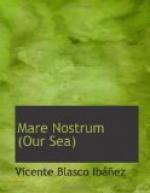He suddenly noticed that it was not as a Russian count that he was speaking since, with brief and exact questions, he was making Ferragut reply just as though he were undergoing an examination.
These signs of interest shown by the great traveler in the little mare nostrum, and especially in the details of its western bowl which he wished to know most minutely, pleased Ferragut greatly.
He might ask him whatever he wished. Ferragut knew mile for mile all its shores,—Spanish, French, and Italian, the surface and also its depths.
Perhaps because he was staying in Naples, Kaledine insisted upon learning especially about that part of the Mediterranean enclosed between Sardinia, southern Italy, and Sicily,—the part which the ancients had called the Tyrrhenian Sea.... Did the captain happen to know those little frequented and almost forgotten islands opposite Sicily?
“I know all about all of them,” replied the sailor boastfully. And without realizing exactly whether it was curiosity on the part of the listener, or whether he was being submitted to an interesting examination, he talked on and on.
He was well acquainted with the archipelago of the Lipari Islands with their mines of sulphur and pumice-stone,—a group of volcanic peaks which rise up from the depths of the Mediterranean. In these the ancients had placed Aeolus, lord of the winds; in these was Stromboli, vomiting forth enormous balls of lava which exploded with the roar of thunder. Its volcanic slag fell again into the chimneys of the crater or rolled down the mountain slopes, falling into the waves.
More to the west, isolated and solitary in a sea free from shoals, was Ustica,—an abrupt and volcanic island that the Phoenicians had colonized and which had served as a refuge for Saracen pilots. Its population was scant and poor. There was nothing to see on it, apart from certain fossil shells interesting to men of science.
But the count showed himself wonderfully interested in this extinct and lonely crater in the midst of a sea frequented only by fishing smacks.
Ferragut had also seen, although far off, at the entrance of the harbor of Trapani, the archipelago of the Aegadian Islands where are the great fishing grounds of the tunny. Once he had disembarked in the island of Pantellaria, situated halfway between Sicily and Africa. It was a very high, volcanic cone that came up in the midst of the strait and had at its base alkaline lakes, sulphurous fumes, thermal waters, and prehistoric constructions of great stone blocks similar to those in Sardinia and the Balearic Islands. Boats bound for Tunis and Tripoli used to carry cargoes of raisins, the only export from this ancient Phoenician colony.
Between Pantellaria and Sicily the ocean floor was considerably elevated, having on its back an aquatic layer that in some points was only twelve yards thick. It was the great shoal called the Aventura, a volcanic swelling, a double submerged island, the submarine pedestal of Sicily.




